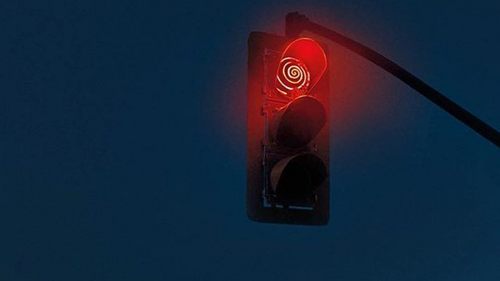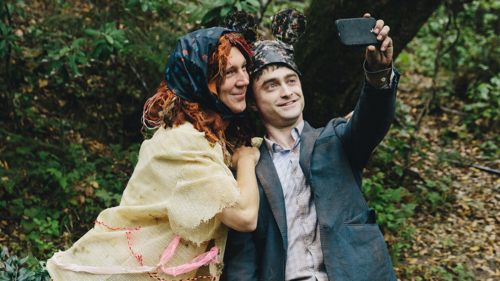Over My Dead Body: SAW And The Genius Of A Simple Twist
In honor of Swiss Army Man, which you can buy tickets for here, we're proud to present Over My Dead Body, a week-long series of articles on films that prominently feature corpses.
It's difficult to imagine Saw's gnarly twist staying a secret in today's media-saturated society. Nowadays, every detail is spoiled at the earliest possible opportunity and barely any secrets are left out of movie trailers, particularly when it comes to horror.
Twelve years ago, when Saw was first released, people weren't running to tell Twitter because there was no Twitter. Facebook wasn't awash with furious discussions about what it all meant because the site was still limited to Harvard students (though maybe those guys were mad?). Anybody curious enough to see the movie went, told their friends about it, word spread and the rest is history.
Dreamed up by long-time buds James Wan and Leigh Whannell - who, unsurprisingly, bonded at film school over a shared love of schlocky horror movies - Saw was originally envisioned as a scummy, single-location piece that would be shot for nothing in a garage. The idea was inspired by the trap set up in Mad Max, which was naturally a key influence on two wannabe Aussie film-makers.
When Twisted Pictures picked it up, on the strength of a five-minute short along with Wan and Whannell's enthusiastic testimony, everything changed. Soon, what Wan lovingly described as a "rough", "cheap" indie movie became a massive worldwide hit, spawning six sequels, released annually on Halloween, each somehow worse than the last.
The debate rages on among horror fans about whether Saw kick-started the much-maligned torture porn sub-genre (it did) but, taken as its own entity, the movie is still hard to beat - especially in comparison to something like Hostel. Kind of an updated, rougher version of Se7en - with which it has much in common (Wan describes the movie as a mystery thriller) - if Se7en were shot by a metal-head whose main artistic influence to date was Slipknot videos, Saw was smarter than its compatriots from the outset. It's also, likely, not as gory as you remember.
Much, if not all of its power comes from the film's central twist which, in 2004, was exactly the shot in the arm horror needed. This was a year that offered genre fans a multitude of remakes and sequels (among the best was Zack Snyder's Dawn Of The Dead - take from that what you will). Considering it came out of virtually nowhere, Saw was a welcome respite, something tantalisingly new and different that rightfully lit up the multiplexes.
That very first reveal of the dead body - bloody, gory, gooey, splayed out in the middle of the floor as the camera spins wildly out of control, capturing the horrifying situation as it dawns on the two men sitting on either side - establishes the movie's darker, mature tone immediately. That corpse is the key to everything; the tape recorder, the gun, and, of course, the twist.
Even more than a decade later, the big reveal is still shocking. It's simple, it's annoyingly obvious (hints are scattered throughout, evident upon re-watch, such as the non-corpse in Amanda's trial) and it hits harder than anything else in the movie or, indeed, the series. And yet, one wishes it had been given more time to marinate and allow us to (forgive me) piece the jigsaw puzzle together ourselves, instead of having it spelled out.
In a tenth anniversary chat with The A.V Club, Whannell bemoaned how audiences had latched on to the Jigsaw character, and the traps themselves, instead of focusing on the two guys in the room, whose plight he and Wan saw as the "the juice" of the story. The writer (who also scripted two sequels) feels Saw was tainted by subsequent films moving further and further away from characters and concentrating instead on blood and guts.
Shot for about $700K in just over two weeks, the flick remains a master-class in tension, suspense and ingenuity, cleverly cheating its single location with flashbacks that flesh out the story without the need for useless exposition. It may not be the masterpiece many claim (and it certainly doesn’t come close to matching Se7en) but Saw has a furiously low-budget, grimy feel to it that lends itself extremely well to the material.
Wan maintains the reason it hit so hard with audiences was that twist ending, even though the idea of a corpse not really being a corpse seems kind of quaint nowadays. Regardless, it remains one of the coolest, and simplest, reveals in modern horror. The point may be hammered home immediately afterwards, but in that moment, as Jigsaw slowly stands up in the background of the shot and the camera focuses in on him tearing the fake wound off his head, millions of movie-goers lost their collective minds. Even now, knowing what's coming, that reveal still packs a serious punch.
Saw may be slightly overcooked at times and the performances, particularly Cary Elwes', border on melodramatic (though Whannell has never been better as an actor; his recent exploits in the Insidious series show him struggle even to maintain a consistent accent). And yet, that twist holds up. True, it would've been better had the story been allowed to end there instead of becoming convoluted to the point of ridiculousness in six further chapters. But, as Whannell noted recently, the idea behind the movie itself hasn't aged. The traps may have grown more sophisticated, and Jigsaw may have found a, erm, worthy successor, but for all the (deserved) criticism the series receives, when Saw kept it simple, and its twist plausible, it hit harder than hundreds of sophisticated traps and dismembered body parts.
If only every other torture porn wannabe that followed had taken note.



_500_281_81_s_c1.jpg)